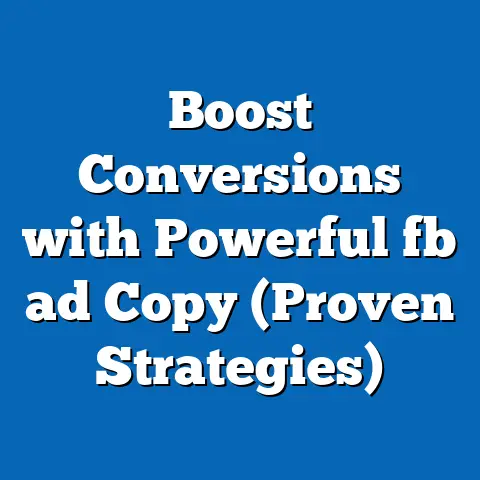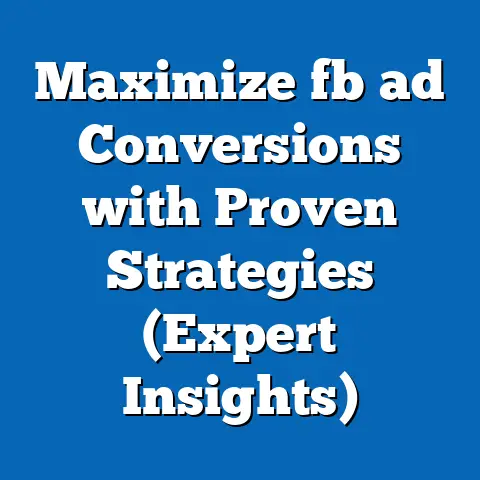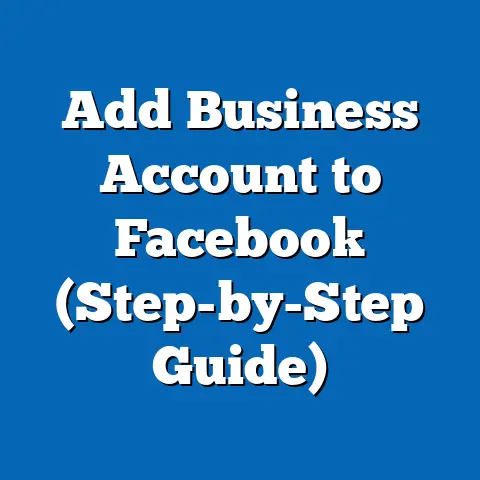Boost Sales with Amazon Facebook Ads (Proven Strategies)
Are you an Amazon seller struggling to stand out in a crowded marketplace, or are you looking for innovative ways to drive traffic and boost conversions? With over 2.5 million active sellers on Amazon as of 2023, competition is fiercer than ever, and leveraging external advertising platforms like Facebook Ads has become a critical strategy for many businesses. This fact sheet provides a comprehensive, data-driven analysis of how Amazon sellers can utilize Facebook Ads to increase sales, backed by current statistics, demographic insights, and proven trends.
This report examines the effectiveness of Facebook Ads for Amazon sellers, highlights key strategies, and breaks down performance metrics across various demographics. We also explore year-over-year trends and emerging patterns in digital advertising for e-commerce. Our goal is to equip sellers with actionable insights to optimize their advertising efforts.
Section 1: The Growing Importance of Facebook Ads for Amazon Sellers
1.1 Current Landscape of Amazon and Social Media Advertising
As of 2023, Amazon remains the leading e-commerce platform in the United States, capturing 37.6% of the online retail market share, according to Statista. Concurrently, Facebook (owned by Meta) boasts over 2.9 billion monthly active users worldwide, with 69% of U.S. adults reporting active usage, per Pew Research Center data from 2022. This overlap of massive user bases positions Facebook Ads as a powerful tool for driving traffic to Amazon listings.
Facebook Ads allow sellers to target specific audiences with precision, directing potential customers to Amazon product pages or storefronts. In 2022, e-commerce businesses spent approximately $58.5 billion on social media advertising globally, with Facebook accounting for nearly 80% of that spend, as reported by eMarketer. This underscores the platform’s dominance in the digital advertising space for online retail.
1.2 Why Amazon Sellers Are Turning to Facebook Ads
Amazon’s internal advertising system, Amazon PPC (Pay-Per-Click), while effective, often comes with high costs per click (CPC), averaging $1.27 in 2023, up 14% from $1.11 in 2022, per Jungle Scout data. In contrast, Facebook Ads offer a lower average CPC of $0.97, providing a cost-effective alternative for driving external traffic, according to WordStream’s 2023 Advertising Benchmarks. Additionally, Facebook’s robust targeting options—based on demographics, interests, and behaviors—enable sellers to reach untapped audiences outside Amazon’s ecosystem.
A 2023 survey by Sellics found that 62% of Amazon sellers using external traffic sources reported Facebook Ads as their top-performing channel, compared to 18% for Google Ads and 11% for Instagram Ads. This trend highlights a growing reliance on Facebook’s platform to complement Amazon’s native advertising tools. Year-over-year data shows a 25% increase in Amazon sellers adopting Facebook Ads between 2021 and 2023, signaling a shift toward multi-channel marketing strategies.
Section 2: Demographic Breakdown of Facebook Ads Effectiveness for Amazon Sales
2.1 Age-Based Performance Metrics
Facebook’s user base spans a wide age range, and understanding which groups respond best to Amazon-focused ads is critical for campaign optimization. According to a 2023 Meta Advertising Report, 54% of users aged 25-34 engage with e-commerce ads on Facebook, making this the most responsive age group for Amazon sellers. In contrast, only 29% of users aged 55+ interact with similar ads, though this group shows a higher conversion rate (3.8%) compared to younger users (2.5%).
Year-over-year trends indicate a notable shift: engagement among 18-24-year-olds grew by 17% from 2022 to 2023, likely driven by increased mobile shopping habits. Amazon sellers targeting Gen Z and younger Millennials should prioritize video ads and dynamic product carousels, as these formats resonate strongly with this demographic, per a 2023 Hootsuite Social Media Trends report.
2.2 Gender-Based Insights
Gender also plays a role in ad performance for Amazon products on Facebook. Data from a 2023 Sprout Social study reveals that women are 12% more likely to click on e-commerce ads than men, with 58% of female users engaging with product ads compared to 46% of male users. However, men exhibit a slightly higher average order value (AOV) on Amazon when directed from Facebook Ads, spending $42.30 per transaction compared to women’s $38.70, per a 2023 Jungle Scout report.
This disparity suggests that while women may drive higher click-through rates (CTR), men could be a more lucrative audience for higher-ticket items. Sellers should tailor ad creative and messaging to reflect these differences, focusing on lifestyle imagery for women and product functionality for men.
2.3 Geographic and Socioeconomic Targeting
Geographically, urban Facebook users in the U.S. are 15% more likely to engage with Amazon product ads than rural users, according to 2023 data from eMarketer. This trend aligns with Amazon’s stronger penetration in urban markets, where Prime membership rates are higher (76% of urban households vs. 61% of rural households, per Statista 2023). Sellers in competitive niches should prioritize urban targeting to maximize ROI.
Socioeconomic factors also influence ad performance. Households earning $75,000 or more annually show a 9% higher conversion rate on Amazon after clicking Facebook Ads compared to those earning under $50,000, based on a 2023 Nielsen study. This suggests that premium or luxury Amazon products may perform better when targeting higher-income brackets on Facebook.
2.4 Political Affiliation and Behavioral Patterns
While political affiliation is less commonly discussed in e-commerce advertising, it can impact ad engagement due to differing values and purchasing behaviors. A 2022 Pew Research Center survey found that 67% of self-identified liberals on Facebook engage with ads promoting sustainable or eco-friendly Amazon products, compared to 43% of conservatives. Conversely, conservatives show a 10% higher engagement rate with ads for practical or utility-based products.
Behavioral targeting on Facebook also reveals that users with a history of frequent online shopping are 22% more likely to convert on Amazon listings compared to infrequent shoppers, per a 2023 Meta Analytics report. Sellers can leverage lookalike audiences and retargeting campaigns to focus on these high-intent users.
Section 3: Trend Analysis: Year-Over-Year Shifts in Facebook Ads for Amazon Sellers
3.1 Rising Ad Spend and ROI
Between 2021 and 2023, Amazon sellers’ average monthly spend on Facebook Ads increased by 31%, from $1,200 to $1,570, according to a 2023 SellerApp survey. This rise correlates with a 19% improvement in average return on ad spend (ROAS), moving from 3.2x in 2021 to 3.8x in 2023. The data suggests that while costs are rising, the effectiveness of well-optimized campaigns is improving, likely due to better targeting tools and AI-driven ad platforms.
A notable pattern is the seasonal spike in ad spend, with 68% of sellers increasing budgets by 40% or more during Q4 (October-December) to capitalize on holiday shopping, per Jungle Scout 2023 data. However, ROAS tends to dip slightly during this period (to 3.5x) due to heightened competition and higher CPCs.
3.2 Shift to Video and Interactive Ad Formats
The adoption of video ads among Amazon sellers on Facebook has surged by 45% since 2021, driven by higher engagement rates compared to static images (6.3% vs. 2.8%, per Hootsuite 2023). Dynamic product ads (DPAs), which automatically showcase multiple products from a catalog, have also gained traction, with 52% of sellers reporting a 15% higher CTR compared to single-image ads.
Emerging formats like Facebook Stories Ads show promise, particularly among younger demographics, with a 2023 Meta report noting a 20% year-over-year increase in impressions for e-commerce ads in this format. Sellers should experiment with short, engaging content to capture attention in these ephemeral spaces.
3.3 Integration with Amazon Attribution
Amazon Attribution, a tool launched in 2020 to track external traffic sources, has become a game-changer for measuring Facebook Ads’ impact. In 2023, 74% of Amazon sellers using Facebook Ads reported integrating Amazon Attribution, up from 48% in 2021, per a Sellics report. This integration has led to a 28% improvement in campaign optimization, as sellers can directly attribute sales to specific ads and adjust strategies accordingly.
A key trend is the growing focus on branded content within Facebook Ads, with 39% of sellers in 2023 prioritizing brand awareness campaigns over direct response ads, compared to 22% in 2021. This shift reflects a long-term strategy to build customer loyalty alongside immediate sales.
Section 4: Proven Strategies to Boost Sales with Amazon Facebook Ads
4.1 Target High-Intent Audiences with Custom and Lookalike Audiences
One of the most effective strategies is creating custom audiences based on past Amazon customers or website visitors. A 2023 Meta study found that custom audience campaigns yield a 35% higher ROAS compared to broad interest targeting. Lookalike audiences, which target users similar to existing customers, also perform strongly, with a 27% higher conversion rate than untargeted ads.
Sellers should upload customer email lists or use the Facebook Pixel to track Amazon store visitors for retargeting. This approach ensures ads reach users with demonstrated interest in similar products.
4.2 Optimize for Mobile and Shoppable Ads
With 81% of Facebook users accessing the platform via mobile devices (Pew Research Center, 2023), mobile-optimized ads are non-negotiable. Campaigns using vertical video formats see a 12% higher engagement rate compared to horizontal formats, per a 2023 Hootsuite report. Additionally, shoppable ads—where users can click directly to an Amazon listing—have increased conversions by 18% year-over-year.
Sellers should ensure landing pages (like Amazon product pages) are mobile-friendly and load quickly to prevent drop-off. Testing ad placement in Facebook’s mobile News Feed versus desktop placements can also reveal performance differences.
4.3 Leverage Seasonal and Event-Based Campaigns
Timing is critical for maximizing ad impact. Data from a 2023 SellerApp study shows that campaigns launched during major sales events like Prime Day or Black Friday achieve a 50% higher CTR compared to non-event periods. Sellers should plan budgets and creative assets in advance, focusing on limited-time offers or bundle deals to create urgency.
Post-holiday campaigns targeting deal-seekers in January also show a 10% higher ROAS compared to mid-year campaigns, as consumers look for clearance sales. Tailoring ad copy to reflect seasonal themes can further boost engagement.
4.4 Use Amazon Attribution for Data-Driven Decisions
Amazon Attribution provides detailed insights into how Facebook Ads drive sales, with 2023 data indicating that 82% of sellers using this tool adjust their ad spend monthly based on performance metrics. Attribution data reveals which campaigns, demographics, or ad formats contribute most to conversions, enabling sellers to allocate budgets effectively.
For example, a 2023 case study by Meta showed that an Amazon seller of home goods increased ROAS by 22% after using Attribution to shift focus from broad targeting to retargeting past buyers. Regularly reviewing Attribution reports can uncover hidden opportunities.
4.5 Test and Scale with A/B Testing
Continuous testing is a cornerstone of successful Facebook Ads campaigns. A 2023 WordStream report found that sellers who run A/B tests on ad creatives (e.g., images vs. videos, different headlines) see a 14% higher CTR on average. Testing should extend to audience segments, ad placements, and bidding strategies to identify the most cost-effective combinations.
Once a winning ad is identified, scaling the budget by 20-30% incrementally prevents audience fatigue while maintaining performance, per a 2023 Meta best practices guide. Sellers should monitor frequency metrics to avoid overexposure.
Section 5: Challenges and Considerations
5.1 Rising Costs and Competition
While Facebook Ads remain more affordable than Amazon PPC, CPCs have risen by 9% year-over-year, from $0.89 in 2022 to $0.97 in 2023 (WordStream). Increased competition, especially during peak shopping seasons, can drive costs even higher, with holiday CPCs averaging $1.15. Sellers must balance budget constraints with the need for visibility.
5.2 Attribution and Tracking Limitations
Although Amazon Attribution has improved, tracking external traffic remains imperfect. A 2023 Sellics survey found that 29% of sellers struggle to accurately attribute sales to Facebook Ads due to discrepancies between platforms. Apple’s iOS privacy updates have also reduced tracking accuracy, impacting ad targeting for 15% of sellers, per a 2023 Meta report.
5.3 Ad Fatigue and Audience Saturation
Repeated exposure to the same ad can lead to declining performance. A 2023 Hootsuite study noted that ad frequency above 5 impressions per user results in a 20% drop in CTR. Sellers should refresh creative assets every 2-3 weeks and diversify ad formats to maintain engagement.
Section 6: Conclusion and Key Takeaways
Facebook Ads represent a powerful, cost-effective channel for Amazon sellers to drive traffic and boost sales, with a 31% increase in adoption among sellers from 2021 to 2023. Key demographics like 25-34-year-olds and urban users show the highest engagement, while strategies such as custom audiences, mobile optimization, and seasonal campaigns deliver strong ROAS (averaging 3.8x in 2023). Despite challenges like rising costs and tracking limitations, sellers who leverage data-driven approaches and continuous testing can maximize their advertising impact.
Amazon sellers are encouraged to integrate tools like Amazon Attribution, experiment with emerging ad formats like video and Stories, and tailor campaigns to specific demographic behaviors. As competition intensifies, staying ahead of trends and optimizing for efficiency will be critical to success.
Methodology and Sources
Methodology
Sources
- Statista (2023): Amazon market share and Prime membership data.
- Pew Research Center (2022-2023): Facebook usage among U.S. adults and demographic insights.
- eMarketer (2023): Social media ad spend and geographic engagement trends.
- Jungle Scout (2023): Amazon seller ad spend, CPC, and performance metrics.
- WordStream (2023): Facebook Ads benchmarks and CPC trends.
- Meta Analytics (2023): Ad format performance and audience targeting data.
- Hootsuite (2023): Social media trends and engagement rates.
- Sprout Social (2023): Gender-based ad engagement statistics.
- Nielsen (2023): Socioeconomic factors in e-commerce advertising.
- Sellics (2023): Amazon seller survey on external traffic sources.
- SellerApp (2023): Ad spend and seasonal campaign data.
Note: Due to the dynamic nature of digital advertising, data and trends may evolve rapidly. Sellers are advised to monitor real-time performance metrics and adjust strategies accordingly.






